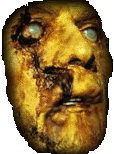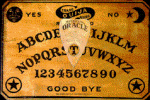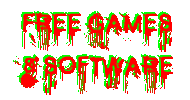TRIVIA
* Bosco chocolate syrup was used to simulate the blood in the film.
* The zombie hand that Tom (Keith Wayne) hacks up with a kitchen knife was made of clay and filled with chocolate syrup.
* When the zombies are eating the bodies in the burnt-out truck they were actually eating roast ham covered in chocolate sauce. The filmmakers joked that it was so nausea inducing that it was almost a waste of time putting the makeup on the zombies, as they ended up looking pale and sick anyway.
* The gas pump was not bolted to the ground when the actress who played Barbra, Judith O'Dea, runs into it at the start of the film. She did it with so much force she almost tipped it over on the cameraman.
* One of the working titles for this film was "Night of Anubis". Anubis is the god of embalming/mummifying in the ancient Egyptian (Kemetan) religion.
* One of the working titles for this film was "Night of the Flesh Eaters". Originally, the beings attacking the characters were extraterrestrial in origin, either aliens or humans possessed by an alien pathogen, presumably covering a NASA satellite returning from Venus. Eventually, it was decided that the dead would rise and devour the living, presumably due to radiation that was carried by a NASA satellite returning from Venus.
* Though the radiation of a detonated satellite returning from Venus is theorized to be the cause of the dead rising and attacking the living, according to the filmmakers, the actual cause is never determined.
* Columbia Pictures was the only major Hollywood studio interested in distributing this film, but eventually passed because it was in black-and-white at a time when movies had to compete with new color televisions. Ironically, Columbia did distribute the 1990 color remake. American International Pictures (AIP) considered releasing the film, but wanted George A. Romero to shoot an upbeat ending and add more of a love story subplot.
* During the filming of the cemetery sequence, shot on two separate days, an unexpected accident caused a fast change of script. The car driven by Barbara and Johnny into the cemetery was actually owned by the mother of Russell Streiner. Unfortunately, sometime between the two filming sequences, someone ran into the car and put a dent in it that would easily be visible on camera. George A. Romero rewrote the scene so the car would come to a stop by crashing into a tree.
* In the scene where Ben is nailing wooden boards to the door, small numbers can be seen on them. These were written on the backs of the boards so they could be removed and replaced in between shots, preserving continuity. Some numbers are visible because some of the boards were nailed on backwards.
* Tom Savini was originally hired by George A. Romero to do the makeup effects for this film. The two were first introduced to each other when Savini auditioned for an acting role in an earlier film that never got off the ground. Romero, remembering that Savini was also a makeup artist (he had brought his makeup portfolio to show to Romero at the audition), called Savini to the set of his horror movie. However, Savini was unable to do the effects because he was called to duty by the US Army to serve as a combat photographer in Vietnam.
* The film's first scene, the initial cemetery attack on Barbara and Johnny, was the last filmed, in November 1967. The actors had to hold their breath to avoid visible condensation in the frosty autumn air.
* According to George A. Romero, the film was originally ten minutes longer but the distributor pressured him to cut it down.
* The word "zombie" is never used. The most common euphemism used to describe the living dead is "those things," mostly by Cooper.
* Bill 'Chilly Billy' Cardille, who played the television reporter, was indeed a local Pittsburgh TV celebrity. Known as "Chilly Billy" Cardille, he hosted a horror movie program on Channel 11 and occasionally reported the news.
* S. William Hinzman and Karl Hardman, two of the original $300 investors had small roles due to a shortage of available talent. Another investor was a butcher, who provided some blood and guts.
* Actor/co-producer Karl Hardman (Harry Cooper, the father in the basement), also served as makeup artist, electronic sound effects engineer, and took the still photos used for the closing credits.
* When the writers decided to base the film on zombies, they brainstormed about what would be the most shocking thing for the zombies to do to people and decided on cannibalism.
* During production, the film's title was still being chosen. The working title was simply "Monster Flick".
* The character of Ben was originally supposed to be a crude but resourceful truck driver. After 'Duane Jones (I)' auditioned for the part, director and co-writer George A. Romero re-wrote the part to fit his performance.
* George A. Romero has readily admitted that Herk Harvey's Carnival of Souls (1962) was a big influence in his making of this film.
* The main house did not have a true basement but a dirt potter's cellar, and thus had no long staircase leading down to it. Because of this, the basement scenes were filmed in the editing studio's cellar.
* In the 30th Anniversary Edition, the car that drops off Debbie Rochon at the medical center is driven by Marilyn Eastman (Helen Cooper) and owned by Karl Hardman (Harry Cooper).
* The music used in the film was from a Capitol/EMI Records Hi-Q stock music library, on which the copyright was in the public domain, and cost the filmmakers $1500. It was originally used in Teenagers from Outer Space (1959).
* When the movie was in its scripting stage, John A. Russo had developed an idea that was basically described as "teenagers from outer space". This version was not filmed, but the version that was filmed uses stock music from the movie Teenagers from Outer Space (1959).
* One of the Walter Reade Organization's publicity stunts was a $50,000 insurance policy against anyone dying from a heart attack while watching the film.
* The film's world premiere was at the Fulton Theatre in Pittsburgh, Pennsylvania, on 1 October 1968 (At 8PM, admission by invitation only). The film was met with a standing ovation.
* The only real mishap to happen during filming involved producer and actor Russell Streiner's (Johnny's) brother, Gary Streiner. After the scene where 'Duane Jones (I)' sets the chair on fire, it was Gary's responsibility to extinguish the flames and set the chair ablaze again to preserve continuity, ensuring that smoke would be seen emanating from it near the end of the film. At one point Gary's sleeve caught on fire and, as he ran in terror, S. William Hinzman (in full zombie makeup) tackled him to the ground and helped extinguish the flames, saving him from major injury.
* George A. Romero was the one operating the camera when S. William Hinzman (the cemetery zombie) attacks Barbara in her car by smashing the window with a rock. When Hinzman shattered the window, the rock barely missed Romero.
* Some of the groans made by S. William Hinzman when he's wrestling with Russell Streiner in the cemetery are authentic. During the struggle, Streiner accidentally kneed Hinzman in the groin.
* The Evans City Cemetery was the cemetery used in the original version of the film, but it could not be used for the 30th anniversary edition. Before filming the new footage, a tornado had torn through the Evans City Cemetery, and ironically, it unearthed several graves.
* The Chevy truck seen in the new footage is not the same one seen in the original footage. The filmmakers for the new footage were fortunate enough to find a truck owned by a local resident that bore a near-perfect resemblance to the original truck. The owner was kind enough to let them borrow his truck for the film.
* During the filming of the new footage for the 30th anniversary edition, actor/composer Scott Vladimir Licina (Reverend John Hicks) suffered a heat stroke in the cemetery and was hospitalized for a few days.
* The house used for this film was loaned to the filmmakers by the owner, who planned to demolish it anyway, thereby ensuring that they could do whatever they wanted to the house.
* There were two trucks used in the film. The first one used in the beginning of the film would not start for the trek-to-the-gas-pump scenes and had to be replaced. Unfortunately, they forgot to break the headlights.
* While writing the script, George A. Romero and John A. Russo were trying to think of a manner in which to destroy the zombies. Marilyn Eastman joked that they could throw pies in their faces. This is obviously an inspiration for the pie fight scene in this film's sequel, Dawn of the Dead (1978).
* Judith Ridley worked as a receptionist for Karl Hardman and Marilyn Eastman, which led to her getting the part in the movie.
* Assuming the movie takes place on the spring time change (according to the dialog at the beginning) after the date (December 1966) on the calendar in the house (a reasonable assumption from the condition of the body in the house), the movie begins on the night of 30 April 1967 and ends the next morning, which is May Day.
* The body upstairs in the house was made by director George A. Romero, who used ping-pong balls for the eyes.
* S. William Hinzman based his characteristic saunter (and, subsequently, that of each other zombie) on a film with Boris Karloff, the title of which he could not remember. In that film, Karloff played a man risen from the dead, and walks with a characteristic ungainly saunter.
* According to the George A. Romero commentary track on the Elite laserdisc and DVD version of the film, the original working print and working elements and materials for the film no longer exist - they were destroyed as a result of a flood that filled the basement where the materials were stored (which was the same basement used in the movie).
* At between 51 and 52 minutes into the film, going by the Elite laserdisc/DVD release, there is a very visible jump cut. The distributors wanted some of the "talky" bits trimmed down, so, about 6 minutes was cut from a basement scene involving the Coopers. The jump is quite clearly visible because at one point Harry is facing one direction and then immediately in the next frame, he is facing another.
* At the time of the film's release, any work that did not include a copyright notice was assumed to be public domain. Since the film makers forgot to include this notice, the film slipped into the public domain. In was not until 1 March 1989 that a copyright notice was no longer required.
* Screenwriter John A. Russo appears as the ghoul who gets his forehead smashed by Ben with a tire iron. He also allowed himself to be set on fire for real when nobody else wanted to do the stunt.
* The Cooper family are played by a real family. Karl Hardman (husband Harry Cooper) and Marilyn Eastman (wife Helen Cooper) are real-life husband and wife. Kyra Schon (daughter Karen Cooper) is Karl's daughter, as well as Marilyn's step-daughter.
* This was one of the first films added to the National Film Registry of the Library of Congress because of naïve business practices that allowed the copyright of the film to slip into the public domain.
* The filmmakers were accused of being "Satanically-inspired" by Christian fundamentalist groups for their portrayal of the undead feeding on flesh and of the Coopers' zombie child (Kyra Schon) attacking her mother (Marilyn Eastman).
* One of the original ideas for the script before its many revisions called for Barbara to be a very strong, charismatic character. Instead, George A. Romero and the producers loved Judith O'Dea's portrayal as a catatonic and terrified young girl much better, and edited the script to accommodate the part. Eventually, the idea of Barbara being a strong, central character would be revisited in Tom Savini's 1990 remake.
* The stock music that accompanies Barbara's initial flight from the cemetery zombie had been used a year earlier, in the final episode of television's "The Fugitive" (1963).
* As George A. Romero explains it on "The Directors: The Films of George A. Romero", the day the final editing and voice-over dubbing was complete (4/4/1968), he and John A. Russo literally "threw" the film into the trunk of their car and drove to New York to see if anyone wanted to show it. While driving through New York on the night of April 4th, 1968, Romero and Russo heard news on the radio that Martin Luther King had been assassinated.
* The role of Ben was originally meant for Rudy Ricci. After 'Duane Jones (I)' had read the part, however, it was given to him, and Ricci played one of the zombies.
* In the scene where Ben moves the body upstairs to another room, we can see that its face is intact. This was in fact Kyra Schon who doubled as the upstairs body as it was felt that a mannequin would look unrealistic.
* This film is ranked at #9 on Bravo's _"100 Scariest Movie Moments, The" (2004) (mini)_ special.
* SPOILER: The social commentary on racism some have seen in this film was never intended (an African-American man holing up in a house with a white woman, a posse of whites shooting a black man in the head without first checking to see if he was a zombie). According to the filmmakers, 'Duane Jones (I)' was simply the best actor for the part of Ben.
* SPOILER: Barbara (Judith O'Dea) was originally meant to be the sole survivor of the zombies' onslaught. This idea is incorporated into the remake of Night of the Living Dead (1990).
* SPOILER: Originally, one idea for the script called for Harry Cooper to die from the gunshot wound received from Ben before his daughter became a zombie, which would have resulted in Helen coming down the stairs to find him eating their daughter, rather than the daughter eating him. It was decided that this would probably be far too disturbing and graphic and was changed back to the idea of the daughter becoming a zombie first.



































